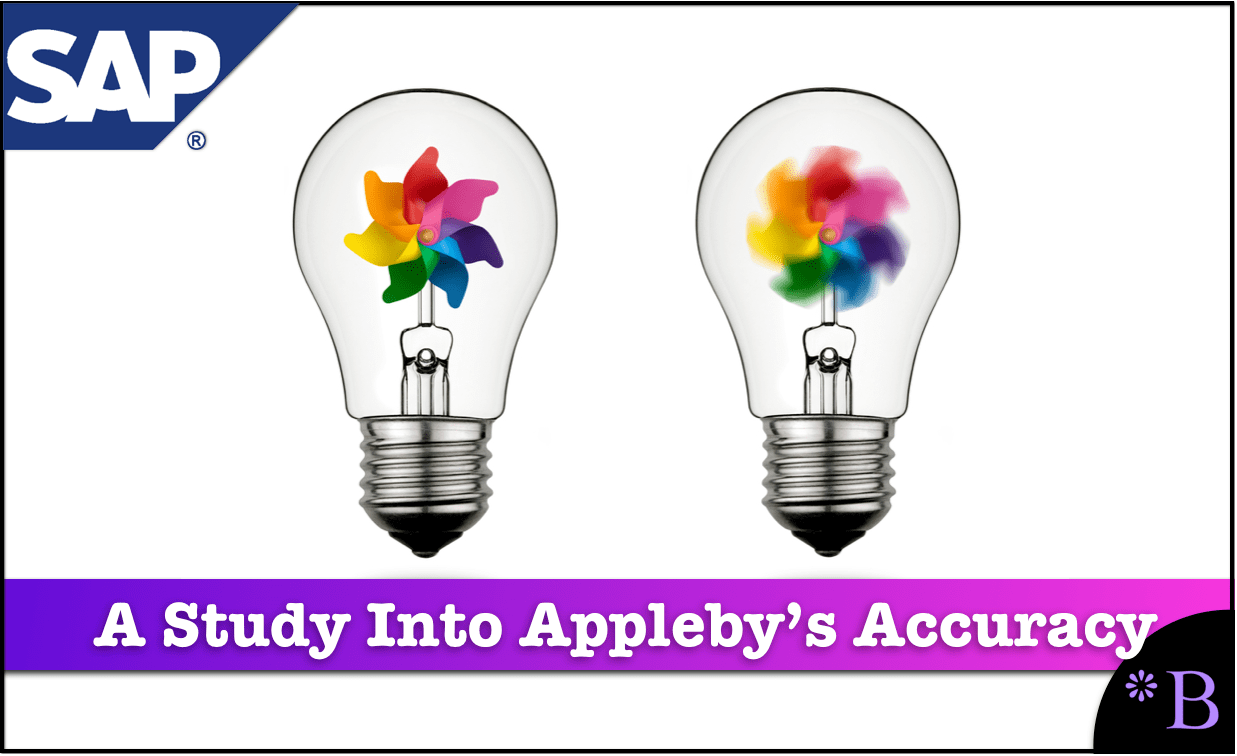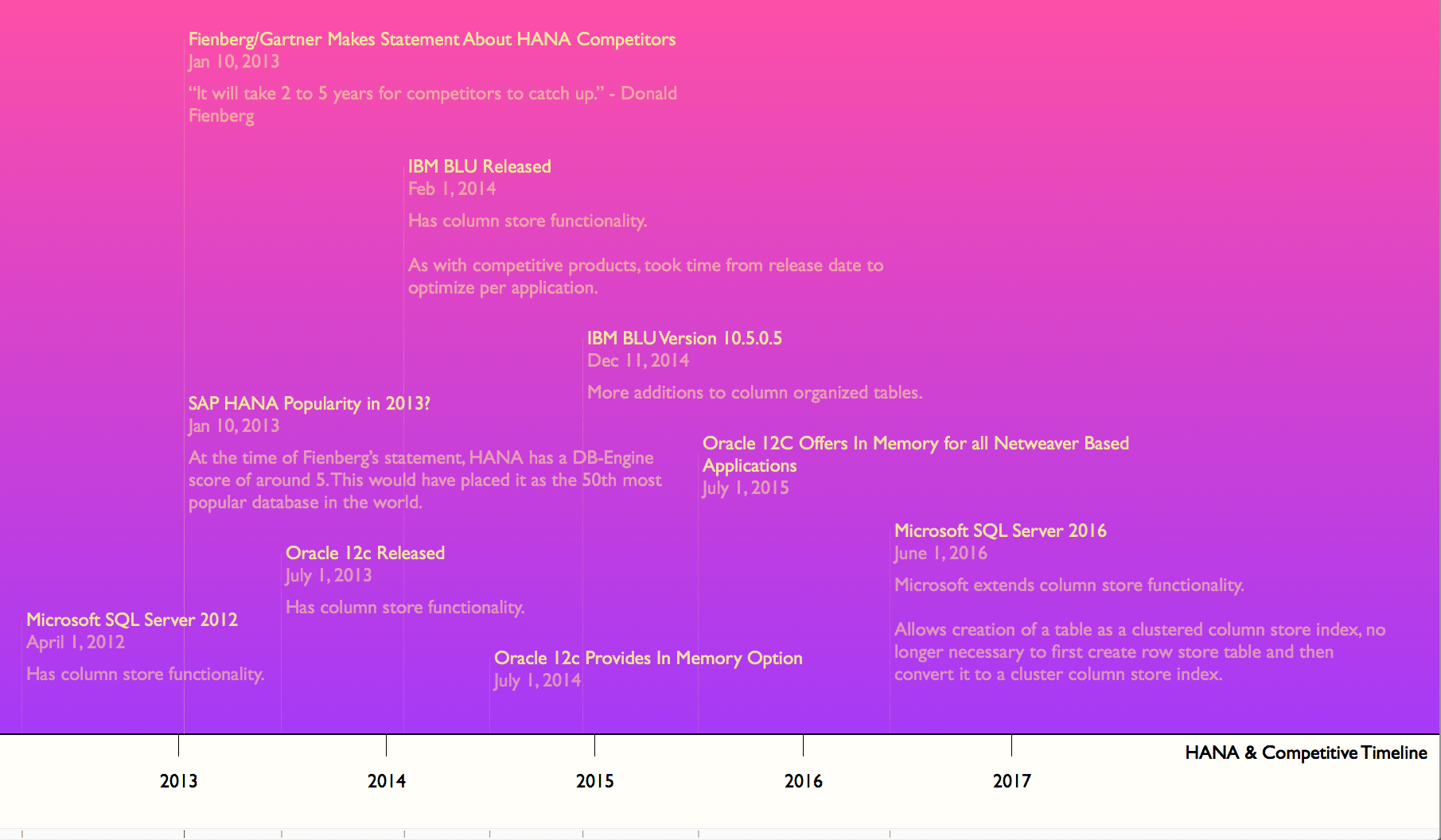How Accurate Was John Appleby on What In-Memory Database for SAP BW?
Executive Summary
- John Appleby made bold predictions on HANA.
- Do we review how accurate he was in his article on What In-Memory Database for SAP BW?

Introduction
John Appleby’s article on the SAP HANA blog was titled What In-Memory Database for SAP BW? A Comparison of the Major Vendors and was published on Nov 13, 2013.
Our References for This Article
If you want to see our references for this article and other related Brightwork articles, see this link.
Notice of Lack of Financial Bias: We have no financial ties to SAP or any other entity mentioned in this article.
The Quotations
Appleby Performs Research?
I get a lot of requests for how SAP HANA compares to IBM and Oracle in-memory databases for the SAP BW software stack. I thought that I’d share the insight that I have found from primary research on all three platforms. Here is a high-level view of my analysis:

The Appleby Papers make up an analysis of over 12 of Appleby’s papers. From our analysis, we have concluded that Appleby does not perform research. See our analysis of his “TCO” study of HANA How Accurate Was John Appleby on HANA TCO for Cloud vs. On-Premises? And How Accurate Was John Appleby on SAP BW-EML Benchmark? Appleby only rigs 1/2 baked “investigations” to promote HANA.
This graphic above is another example. It is easy to figure out why he has placed these vendors in this ranking. Of the database providers, Oracle has most of the database market for SAP. DB2 is less of a threat. Therefore, Appleby positions Oracle as having none of the abilities, where HANA has 100% of the capabilities.
HANA SP06 Has All of the Capabilities of a Mature RDBMS?
“SAP HANA SP06 is the 6th major release of SAP HANA over 3 years and it contains all the major features of a mature RDBMS. What’s more, there are also customers using it for mission-critical workloads like ERPs and there are hundreds of live customers for BW on HANA. It is the only in-memory database with full HA/DR and the only that massively simplifies operation of the system with a single store.”
This article was written at the end of 2013. In 2019, HANA still did not have the capabilities of a mature database. Back in 2013, HANA was highly unstable and still did not have its row oriented store implemented. The idea that the late 2013 version of HANA was as mature as DB2 or Oracle is genuinely laughable. At the time of this publication, HANA probably did have more “in memory capability,” but this quickly changed. However, SAP’s HA lagged Oracle or DB2 at this time.

Oracle 12c provided the column-oriented store with the in-memory capability and (already) had HA by July 1, 2014, which is eight months after this article is published. Later Appleby claims that the 12c release did not include a comparable column store functionality and stated that the July 2014 date is when the true in-memory option was provided.
Secondly, HANA does not merely the data environment because companies did not at this time and had not since then installed multiple applications on a single data store (that is, multiple applications on one HANA database).
BW on HANA Can be Hundreds of Times Faster than Other Databases?
“Most significantly for BW, SAP wrote an OLAP compiler for HANA within the BW product. This means that when you run a query in BW, it is translated to “calculation engine” operators and not to SQL. For complex queries like exception aggregation, HANA does not have to materialize millions of rows within the OLAP server like it does for any other database: instead, all of the calculations are pushed down into the database layer. Impact: BW on HANA is in many cases 100s of times faster than any other database.”
Every software vendor will state that their method of solving a problem technically is superior to their competition. But SAP has been unwilling to back up these claims by allowing competition in benchmarking against competitive databases, as we covered in The Four Hidden Issues with SAP’s BW-EML Benchmark.
DB2 BLU Cannot Accelerate All of the Queries that HANA Can Accelerate?
“DB2 BLU accelerates some of the queries that BWA and HANA accelerate, but not all. Specifically, it accelerates simple query groupings that can be expressed in OpenSQL. However BLU will not accelerate complex queries which cannot be expressed in OpenSQL (e.g. exception aggregation) and this can cause a 100x performance degradation compared to BWA or HANA.”
As with the previous explanation of the complete lack of comparable benchmarks to databases other than HANA, SAP has made no evidence to support this claim and has deliberately rigged the benchmarks, so this comparison could not be made. All we are left with is Appleby’s claims, and Appleby is a lying fire hydrant.
Oracle 12 In Memory
“Oracle talked up the “ungodly” speeds of their Oracle 12 in-memory option at Openworld 2014. But, it doesn’t exist yet and is unlikely to until some time in 2014 – there is no release date. Oracle are a smart company and they have decided to offer the in-memory columnar option as a complimentary option to the row store. Yes, it will keep a synchronized copy of row- and column-store data. This will cause massive inefficiencies and storage costs, which I’m sure is great for Oracle’s engineered systems, which they will no doubt try to sell with it. SAP will presumably support this once it is available, probably some time in 2015. I included an analysis of Oracle 12 in-memory, because Oracle keep telling people that it exists.”
Oracle caught up to HANA with its mid-July 2014 release. Oracle did not do this because it was indeed a need on projects, but to catch up to SAP as SAP created a demand for this. There is still, even in 2019, little need for a mixed OLAP/OLTP database. We covered this in the article, How Accurate with Bloor Research on Oracle In Memory?
Both Bloor Research and we concluded that the “in-memory” capability added to SAP, to DB2, and Oracle was a gimmick that increased the maintenance overhead of those databases.
Only 2 Years Ahead?
“In my opinion, SAP HANA is approximately 2 years ahead of all the other mainstream in-memory databases on the market. It is very clear that Oracle, Microsoft and IBM are very busy building their solutions and I believe they will be good solutions, in time. But in 2013 and probably through 2014, if you want to invest in an in-memory database for SAP BW, there is only one option: SAP HANA.”
Appleby is trying to make the entirety of the database about the in-memory portion of functionality, which is the only area where HANA lead at this time. However, the rest of HANA entirely lagged competing databases in every other dimension. Oracle caught up to HANA in mid-2014, and DB2 did so at the end of 2014. This is not two years, roughly a year after Appleby made this prediction. Appleby wanted companies to completely turn over the database to gain between 6 months and one year of better functionality in one area of the database? And after companies did this, they would not only have a more expensive database than either Oracle or DB2 but would have a far less mature database than Oracle or DB2 and would have a far higher maintenance database than Oracle or DB2. All of this to gain access
This demonstrates the extreme financial bias of Appleby. The only thing Appleby cared about was getting his company more HANA business.
Conclusion
This article receives a .5 out of 10 for accuracy. This article repeats inaccurate SAP and marketing material through a third party that makes it appear as if the information is not directly from SAP.